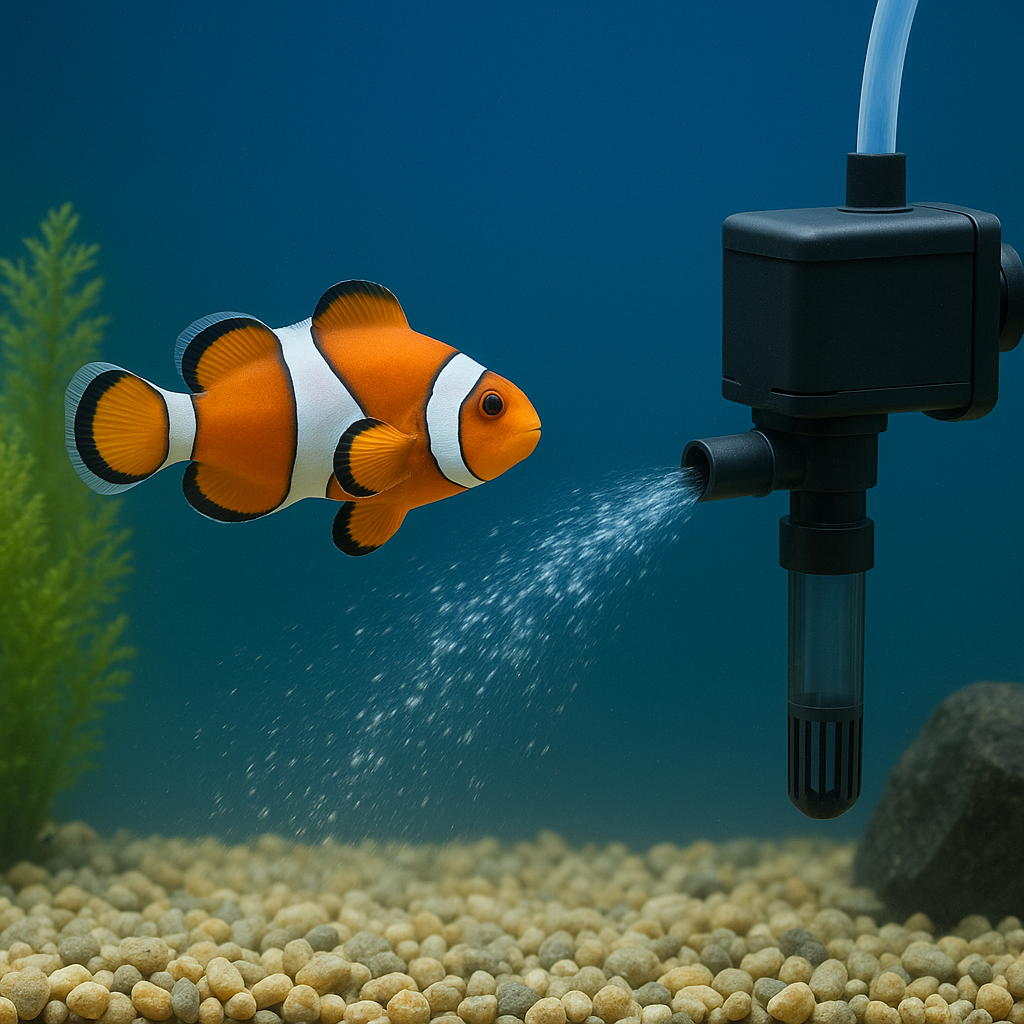An aquarium is a beautiful addition to any home or office, offering a serene and vibrant display of aquatic life. However, maintaining a healthy and thriving aquarium involves more than just feeding your fish and adding decorative plants. One of the most crucial aspects of keeping your fish and plants healthy is ensuring that the water remains clean and oxygenated. That’s where an aquarium filter pump comes in.
In this article, we will explore the significance of using a reliable filter pump, how to select the best aquarium pump for your tank, and the benefits of proper filtration. Clean water is the foundation of a healthy aquarium, and understanding how an efficient filter pump works can help you maintain the perfect aquatic environment for your fish.
What is an Aquarium Filter Pump and How Does It Work?
At its core, an aquarium filter pump is a device that circulates and filters the water in your tank. It works by drawing water through a filtration system, removing debris, waste, and harmful substances, and then releasing the clean water back into the tank. This process not only keeps the water clear but also prevents the build-up of dangerous toxins that could jeopardize your aquatic pets’ health.
Definition and Function of an Aquarium Filter Pump
An aquarium filter pump serves two primary functions: mechanical filtration and biological filtration. Mechanical filtration involves trapping physical debris, such as uneaten food, fish waste, and plant debris. Biological filtration supports beneficial bacteria that break down toxic compounds, like ammonia and nitrites, into less harmful substances. This dual-action system helps to maintain a stable and healthy environment for your fish.
Components of an Aquarium Filter Pump
An aquarium filter pump consists of several components:
- Pump: The motor that circulates the water through the filtration system.
- Filter media: These are materials such as sponges, carbon, or bio-balls that trap particles and support biological filtration.
- Intake tube: This draws water into the filter pump.
- Outflow nozzle: This releases the filtered water back into the tank.
How It Contributes to the Health of Your Aquarium Ecosystem
An aquarium filter pump ensures consistent water circulation, maintaining oxygen levels and preventing stagnant water. Stagnant water is a breeding ground for harmful bacteria and algae, which can quickly harm the delicate balance of your tank. An efficient filter pump helps avoid these issues by promoting healthy water movement and keeping everything clean.
Why Your Aquarium Needs a Reliable Filter Pump
A reliable filter pump is the backbone of any well-maintained aquarium. Here’s why it’s crucial to have one:
Benefits of Clean Water for Fish and Plants
Clean water is essential for the health of your fish, plants, and other aquatic organisms. Fish are susceptible to the quality of the water they live in, and poor water quality can lead to diseases, stunted growth, or even death. Clean water helps maintain a proper pH balance and removes harmful chemicals and toxins, creating a more stable environment for your fish to thrive.
How an Efficient Filter Pump Improves Oxygenation and Circulation
Proper water circulation helps to distribute oxygen evenly throughout the aquarium. Fish and plants rely on oxygenated water for survival, and an efficient filter pump ensures that the water is constantly moving, improving gas exchange. This circulation also prevents dead spots in the tank where waste can accumulate, ensuring that the entire environment is healthy.
Preventing Harmful Bacteria and Algae Build-up
Algae and bacteria can multiply rapidly in an aquarium with poor water filtration. These can not only affect the aesthetic of your tank but also harm the fish and plants inside. A reliable filter pump helps prevent the growth of algae and harmful bacteria by maintaining water flow and promoting the removal of organic matter that serves as a food source for these organisms.
Choosing the Best Aquarium Pump: Key Considerations
Selecting the best aquarium pump for your tank is a critical decision that will impact the overall health and appearance of your aquarium. Here are the key factors to consider:
Factors to Consider When Choosing the Best Aquarium Pump
- Tank Size: The size of your aquarium plays a significant role in determining the right pump. Larger tanks require more powerful pumps to ensure proper circulation and filtration.
- Flow Rate: The flow rate refers to the volume of water the pump can circulate in a given period. It’s typically measured in gallons per hour (GPH). For optimal filtration, aim for a flow rate that can filter the entire tank volume at least 3-5 times per hour.
- Types of Fish and Plants: Different fish species have different needs for water flow. Some fish prefer calm water, while others thrive in strong currents. Consider the needs of your aquatic pets when selecting a pump.
How to Match the Pump to Your Tank Size and Type of Fish
If you have a smaller tank with delicate fish, like bettas or goldfish, choose a pump with a moderate flow rate to avoid overwhelming them with excessive currents. On the other hand, larger tanks with species like cichlids or saltwater fish that enjoy more robust water movement should opt for a more powerful filter pump.
Types of Aquarium Filter Pumps: Internal, External, and Powerhead
- Internal filter pumps are placed inside the tank and are best for smaller aquariums.
- External filter pumps are located outside the tank and are perfect for larger setups, offering more powerful filtration.
- Powerhead pumps are designed to increase water movement and are ideal for larger saltwater tanks or reef setups.
How to Maintain Your Aquarium Filter Pump for Optimal Performance
Regular maintenance is essential to keep your aquarium filter pump functioning effectively. Follow these tips to ensure optimal performance:
Regular Cleaning and Maintenance Tips
- Clean the filter media regularly to prevent clogging and ensure efficient filtration.
- Rinse the pump components in aquarium water to avoid damaging beneficial bacteria.
- Check the pump for any signs of wear or damage, such as leaks or unusual noise.
Troubleshooting Common Issues with Aquarium Filter Pumps
- If the pump is not circulating water properly, check for obstructions or clogs in the intake or outflow tubes.
- If the pump is making loud noises, it may be due to air bubbles, loose components, or debris buildup.
When to Replace Your Filter Pump
While most filter pumps are built to last, they may need to be replaced after several years of use. If your pump is consistently underperforming despite cleaning, it may be time to invest in a new one.
The Latest Trends in Aquarium Filter Pumps
As aquarium technology advances, so does the development of aquarium filter pumps. In 2025, the industry is witnessing some exciting trends that improve the performance and sustainability of filter pumps.
Innovations in Aquarium Pump Technology (2025 Trends)
- Smart Pumps: Some modern pumps come with smart technology, allowing you to monitor and adjust water flow remotely via an app.
- Eco-Friendly Pumps: With a growing focus on sustainability, many pump manufacturers are introducing energy-efficient models that consume less power and reduce environmental impact.
Eco-Friendly and Energy-Efficient Pumps
Energy-efficient pumps are gaining popularity due to their ability to reduce electricity consumption. These pumps provide the same powerful filtration without using excessive amounts of energy, which is not only beneficial for the environment but also for your utility bills.
The Growing Demand for Quiet and High-Performance Pumps
Many aquarium owners, especially those who keep tanks in living spaces, are increasingly concerned about quiet operation. Newer filter pumps are designed to operate with minimal noise, providing a peaceful environment for both fish and humans.
Where to Buy a Reliable Aquarium Filter Pump in the USA
When it comes to purchasing a reliable aquarium filter pump, several online retailers and physical stores offer high-quality products at competitive prices. Trusted platforms include:
- Chewy: Known for its extensive selection of aquarium equipment and competitive pricing.
- Amazon: Offers a wide variety of aquarium filter pumps with detailed customer reviews to guide your purchase.
- Petco: A well-established name in the pet industry, offering reliable aquarium supplies.
Frequently Asked Questions (FAQs)
- What size aquarium pump do I need for my tank?
- The pump should be able to filter the entire volume of your tank 3-5 times per hour. Choose based on your tank size and the type of fish you have.
- How often should I clean my aquarium filter pump?
- Clean your filter pump every 2-4 weeks, depending on the size of your tank and the amount of debris.
- Can I use the same filter pump for freshwater and saltwater tanks?
- Yes, many filter pumps are versatile and can be used for both freshwater and saltwater aquariums, as long as they meet the tank’s specific needs.
- How do I know if my aquarium pump is working correctly?
- If the water flow seems weak or the pump is making unusual noises, check for blockages or signs of wear.
- How long do aquarium filter pumps typically last?
- With proper maintenance, an aquarium filter pump can last anywhere from 3 to 5 years.
Conclusion
A reliable aquarium filter pump is an essential tool for maintaining a clean, healthy, and thriving aquarium. With the right filter pump, you ensure that your fish live in an environment that supports their health and well-being. By choosing the best aquarium pump for your needs and performing regular maintenance, you can enjoy a beautifully balanced tank for years to come.





